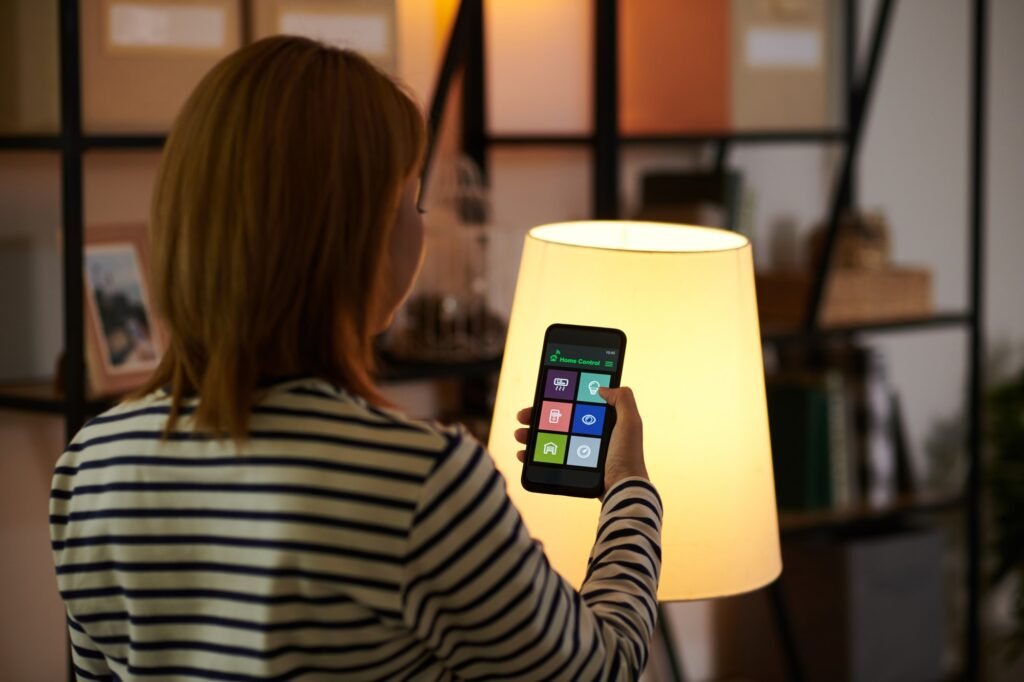In recent years, smart home technology has taken significant strides, providing users with greater control over various aspects of their living spaces. Within this ever-evolving landscape, the concept of Intelligent Lighting Control stands out as a beacon of transformative innovation. This transcends conventional lighting, reshaping our homes into dynamic environments that effortlessly adjust to suit our preferences and emotions. Essentially a tool for crafting ambiance, this blog delves into the intricacies of this technology, highlighting its benefits, functionalities, and key considerations for effective integration.
Enhancing Ambiance through Smart Light Dimming
Smart light dimming, a groundbreaking technology, empowers users to finely tune the brightness of their lights effortlessly, either through a connected device or a simple voice command. Unlike the traditional on/off switch, this innovation transcends basic control, enabling individuals to tailor lighting to perfection for various activities. It represents a paradigm shift in how we engage with illumination, providing the flexibility to transform the ambiance at will. These smart light dimming systems redefine our relationship with light, turning it into a dynamic and responsive element that caters to the diverse moods and needs of individuals with unmatched simplicity and accuracy. Imagine stepping into your living room after a long day. With a simple voice command or tap on your smartphone, the lighting adjusts to a warm, soothing glow, instantly setting a relaxing mood. This seamless transition from a bustling day to a tranquil evening is the magic of smart dimming.
Understanding Smart Light Dimming

Smart light dimming technology employs a range of methods. At its core, these systems utilize advanced control mechanisms integrated within the lighting infrastructure. They encompass a variety of technologies, including adjustable LED bulbs and sophisticated lighting systems, orchestrated to respond to user commands or presets. Compatibility with diverse smart home ecosystems ensures seamless integration and accessibility across various devices and platforms. Exploring this technology unravels the fusion of hardware and software, showcasing the engineering marvel that drives the adaptive and responsive nature of smart light dimming systems. Integrating this technology into your home illuminates the path toward convenience and energy efficiency. You can experience the seamless blend of technology and comfort as your lights adapt to your schedule and preferences.
Also Read: Effortless Efficiency: Smart Home Energy Savings Unveiled
The Benefits Beyond Illumination
While the primary focus remains on controlling brightness, the benefits of smart light dimming systems extend far beyond.
1. Energy Efficiency:
Smart light dimming systems are designed to reduce energy consumption significantly. By adjusting the brightness of lights based on need, these systems contribute to lower electricity usage, leading to reduced energy bills and a more environmentally friendly approach to lighting.
2. Customizable Ambiance:
These systems offer unparalleled flexibility in setting the ambiance. Users can tailor the lighting to suit various activities and moods, from creating a vibrant atmosphere for gatherings to a cozy setting for relaxation, all with the touch of a button or a simple voice command.
3. Convenient Control:
Smart light dimming provides convenient control options. Whether through connected devices like smartphones or voice-activated assistants, users can effortlessly adjust the lighting, eliminating the need for manual adjustments and enhancing overall convenience.
4. Extended Bulb Lifespan:
Dimming lights can extend the lifespan of bulbs. By operating at lower power levels, bulbs endure less stress, leading to a longer lifespan. This translates to reduced replacement frequency and cost savings in the long term.
5. Adaptive and Responsive:
These systems adapt to changing needs seamlessly. The ability to adjust lighting according to natural light levels or specific activities ensures a responsive and adaptable environment that aligns with individual preferences and routines.
6. Enhanced Comfort and Productivity:
The ability to fine-tune lighting enhances both comfort and productivity. From creating a more relaxed setting for winding down to optimizing focus and productivity in workspaces, smart light dimming systems cater to different needs throughout the day.
7. Integration with Smart Home Ecosystems:
These systems integrate seamlessly with other smart home devices and ecosystems. This compatibility allows for synchronized control and automation, creating a holistic smart home experience where lights interact with other devices to enhance functionality and convenience.
How Smart Light Dimming Works
1. Wireless Connectivity:
Most smart dimmers use wireless technologies like Wi-Fi or Bluetooth to connect with a central hub or directly to your smartphone.
2. Compatibility:
Smart dimmers are often compatible with virtual assistants such as Amazon Alexa, Google Assistant, or Apple HomeKit, enabling voice control.
3. App Integration:
Manufacturers provide dedicated apps for controlling smart lights. These apps offer features like scheduling, color adjustment, and scene customization.
Ambiance Control with Smart Light Dimming
1. Color Temperature Adjustment:
Smart lights offer the flexibility to replicate natural daylight, allowing users to select between cooler or warmer tones. This adjustment caters to individual preferences, creating the desired ambiance with a simple setting change.
2. Scene Presets:
Users can establish preconfigured lighting scenes tailored to specific activities, whether it’s setting the mood for a cozy movie night, a romantic dinner, or an energetic party. These presets simplify ambiance creation, offering convenience and enhancing the overall experience.
3. Motion Sensors:
Some smart light dimming systems incorporate motion sensors to automate lighting adjustments based on occupancy. These sensors detect movement within a space, triggering the lights to adjust brightness or turn on/off accordingly, ensuring optimal lighting without manual intervention.
4. Dynamic Color Options:
Beyond adjusting color temperature, smart light dimming systems often offer a diverse range of color options. Users can select from a spectrum of hues, enabling them to create vibrant and personalized lighting atmospheres to suit specific preferences or occasions.
5. Dimming Profiles and Gradual Transitions:
Some systems allow for the creation of dimming profiles or gradual transitions between different light levels. This feature facilitates smoother and more gradual changes in brightness, enhancing the overall ambiance without abrupt shifts.
Seamless Integration for an Enhanced Experience
Seamless integration lies at the core of enhancing the user experience with smart light dimming systems. These innovative technologies effortlessly blend into existing smart home ecosystems, ensuring compatibility with various devices and platforms. This integration enables users to control their lighting alongside other smart devices, creating a unified and synchronized experience. Whether it’s coordinating lights with smart speakers, thermostats, or security systems, the cohesive integration elevates convenience and functionality. The ability to manage lighting alongside other smart home features from a single interface amplifies the overall user experience, offering a streamlined and cohesive approach to home automation. Ultimately, seamless integration not only simplifies control but also enhances the synergy between different aspects of the smart home, providing users with a more cohesive and comprehensive living experience.
Considerations for Implementation
When considering the implementation of smart light dimming systems, several key factors warrant attention to ensure a successful integration:
1. Compatibility and Ecosystem Integration:
Assessing compatibility with existing smart home ecosystems is crucial. Compatibility ensures seamless integration with other devices and platforms, allowing for a cohesive smart home experience.
2. Installation and Setup:
Understanding the installation requirements and setup procedures is essential. Some systems might require professional installation, while others offer DIY setups. Ensuring a smooth installation process is vital for optimal system performance.
3. User Interface and Control:
Evaluating the user interface and control options is pivotal. A user-friendly interface, whether through dedicated apps or voice commands, enhances usability. Assessing the available control options ensures ease of use for all users.
4. Functionality and Features:
Consider the functionalities and features offered by different systems. Assess whether the system aligns with specific needs, such as color customization, scheduling, motion sensors, or remote access.
5. Cost and Scalability:
Understanding the cost implications, including initial investment and potential recurring costs, is crucial. Additionally, considering the scalability of the system in case of future expansions or additions is advisable.
6. Energy Efficiency and Compatibility:
Assessing the energy efficiency of the system and its compatibility with different types of bulbs is essential. Some systems might require specific types of bulbs for optimal performance.
7. Support and Updates:
Investigating the support provided by the manufacturer or service provider is vital. Availability of customer support, warranty, and regular software updates ensures long-term reliability and functionality.
Popular Smart Light Dimming Brands
1. Philips Hue: Renowned for its wide range of smart lighting products, Philips Hue offers an extensive selection of dimmable bulbs, light strips, and smart lighting accessories. Their ecosystem integrates seamlessly with various smart home platforms, providing versatile control options.
2. Lutron Caseta: Lutron Caseta is recognized for its reliable and user-friendly smart lighting solutions. Their dimmers and switches enable users to control lights remotely through dedicated mobile apps or voice commands, offering a straightforward and accessible smart home experience.
3. GE C by GE: GE’s C by GE series offers an array of smart lighting solutions, including dimmable bulbs and smart switches. Known for their ease of installation and compatibility with voice assistants, these products provide a convenient and customizable lighting experience.
4. Nanoleaf: Nanoleaf stands out for its innovative and visually striking smart lighting panels. These dimmable modular panels not only offer customizable lighting but also serve as decorative elements, allowing users to create unique and artistic lighting designs.
5. Wemo: Wemo offers a range of smart switches and dimmers that integrate seamlessly with existing light fixtures, enabling users to control and dim lights remotely via smartphone apps. The brand is recognized for its simple setup and user-friendly interface.
6. Sengled: Sengled provides a variety of smart LED bulbs and lighting kits equipped with dimming capabilities. Their products often offer compatibility with popular smart home ecosystems, allowing for effortless integration and control.
In conclusion, the world of smart light dimming and ambiance control opens up a realm of possibilities, transforming our living spaces into dynamic, personalized environments. As we navigate through the nuances of intelligent lighting, from wireless dimming systems to adaptive technology, it becomes clear that this innovation goes beyond mere illumination. It is a catalyst for enhancing our daily experiences, seamlessly integrating with our lifestyles, and contributing to a more energy-efficient and aesthetically pleasing home. Embracing the future of lighting isn’t just about technological advancement; it’s about curating an atmosphere that aligns with our moods, activities, and individual preferences. With smart light dimming, we embark on a journey where our living spaces truly become an extension of ourselves—adaptable, intuitive, and uniquely ours.
